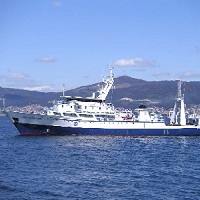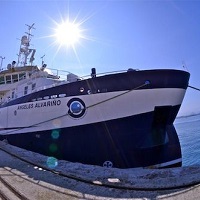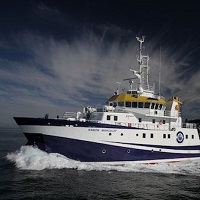Keyword
Concentration of inorganic sulphur species in the water column
8 record(s)
Type of resources
Categories
Topics
INSPIRE themes
Keywords
Contact for the resource
Provided by
Years
Formats
Status
-

Cetaceans, Oceanography and biodiversity of the Deep Waters of El Hierro y La Palma islands
-

The goals of this campaign are framed within the objectives of the overall project, being the experimental cruise of the proposal. Thus, this cruise will help to: - Characterize the different modes of variability of heat and mass transport in easternorth atlantic subtropical gyre. - Determine the structure of the current when it reaches the Canary Islands, mass transport, heat and nutrients and interannual variability. - To determine the correlation between heat and mass transport with the NAO atmospheric and oceanic index. - Characterize the annual cycle in the physical conditions of the surface layers and mixture to where the seasonal cycle is significant, relating it to the meteorological forcings. - Characterization of changes in water masses, mainly in the North Atlantic Central Water (NACW), in Antarctic Atlantic Intermediate Water (AAIW) in Mediterranean Water (MW) and bottom waters of the Canary Basin, in based on temperature, salinity, nutrients and oxygen. - Quantify CO2 transport through atmosphere-ocean of latitude 29 ° N. - Continue with the steps taken for over a year south of La Restinga (El Hierro island) to study the evolution of the physico-chemical on the area of influence of the underwater volcano.
-

The marine ecosystem of the island of El Hierro, one of the richest and most sensitive of the spanish region, is experiencing the consequences of the first recorded underwater eruption in the Canary Islands in the last 500 years of volcanological history. The principal objective of VULCANO is to characterize the marine ecosystem from a physical-chemical-biological approach in order to quantify the environmental impact caused by the eruptive process. This main aim splits into five particular objectives: 1) to characterize the ecosystem before and after the eruption process, 2) to study the spatio-temporal variability of physical, chemical and biogeochemical properties, 3) to evaluate the impact of the eruptive process on lower trophic levels and 4) Characterization of the physiographic, morphological and structural changes on the seafloor associeted to submarine eruptions and 5) the data integration in existing databases, SIG implementation and dissemination by viewers. These objectives will be accomplished through the development of a multidisciplinary working plan which includes the realization of 3 oceanographic cruises and satellite observations.
-

The marine ecosystem of the island of El Hierro, one of the richest and most sensitive of the spanish region, is experiencing the consequences of the first recorded underwater eruption in the Canary Islands in the last 500 years of volcanological history. The principal objective of VULCANO is to characterize the marine ecosystem from a physical-chemical-biological approach in order to quantify the environmental impact caused by the eruptive process. This main aim splits into five particular objectives: 1) to characterize the ecosystem before and after the eruption process, 2) to study the spatio-temporal variability of physical, chemical and biogeochemical properties, 3) to evaluate the impact of the eruptive process on lower trophic levels and 4) Characterization of the physiographic, morphological and structural changes on the seafloor associeted to submarine eruptions and 5) the data integration in existing databases, SIG implementation and dissemination by viewers. These objectives will be accomplished through the development of a multidisciplinary working plan which includes the realization of 3 oceanographic cruises and satellite observations.
-

The main objective of the project "VULcanología CAnaria submariNA, VULCANA", is assess the degree of damage and recovery on the marine ecosystem of the volcano submarine of the island of El Hierro, making it extensible to the volcano "enmedio", between the islands of Gran Canaria and Tenerife. To do this, he held the monitoring of the physico-chemical, biological and geological properties of the submarine process of the island of El Hierro and the submarine volcano "enmedio", giving continuity to the first and only time series data of a multidisciplinary monogenetic submarine volcano in Spanish waters. 1 .- Study of the spatio-temporal variability of physical, chemical and biogeochemical. 2. Evaluation of the impact of the eruption process of trophic lower levels. 3. physiographic, morphological and structural characterization of the seabed associated emissions and adjacent offshore areas.
-

The marine ecosystem of the island of El Hierro, one of the richest and most sensitive of the spanish region, is experiencing the consequences of the first recorded underwater eruption in the Canary Islands in the last 500 years of volcanological history. The principal objective of VULCANO is to characterize the marine ecosystem from a physical-chemical-biological approach in order to quantify the environmental impact caused by the eruptive process. This main aim splits into five particular objectives: 1) to characterize the ecosystem before and after the eruption process, 2) to study the spatio-temporal variability of physical, chemical and biogeochemical properties, 3) to evaluate the impact of the eruptive process on lower trophic levels and 4) Characterization of the physiographic, morphological and structural changes on the seafloor associeted to submarine eruptions and 5) the data integration in existing databases, SIG implementation and dissemination by viewers. These objectives will be accomplished through the development of a multidisciplinary working plan which includes the realization of 3 oceanographic cruises and satellite observations.
-

Multidisciplinary campaing for mooring instruments and adquiring samples and variables to: * Know the thermohaline, kinematic, dynamic and biological characteristics of the Gulf of Cadiz. * Study of carbon fluxes between the Atlantic and Mediterranean. * Linking climatology, hydrology and hydrodynamics and the early stages of development of the species associated with the platform, with a focus on species of fishing interest. * Provide data to feed global and regional numerical models. * Generate and distribute a database to know the evolution of marine climate and its resources.
-

Multidisciplinary campaing for mooring instruments and adquiring samples and variables to: * Know the thermohaline, kinematic, dynamic and biological characteristics of the Gulf of Cadiz. * Study of carbon fluxes between the Atlantic and Mediterranean. * Linking climatology, hydrology and hydrodynamics and the early stages of development of the species associated with the platform, with a focus on species of fishing interest. * Provide data to feed global and regional numerical models. * Generate and distribute a database to know the evolution of marine climate and its resources.
 Catálogo de datos del IEO
Catálogo de datos del IEO